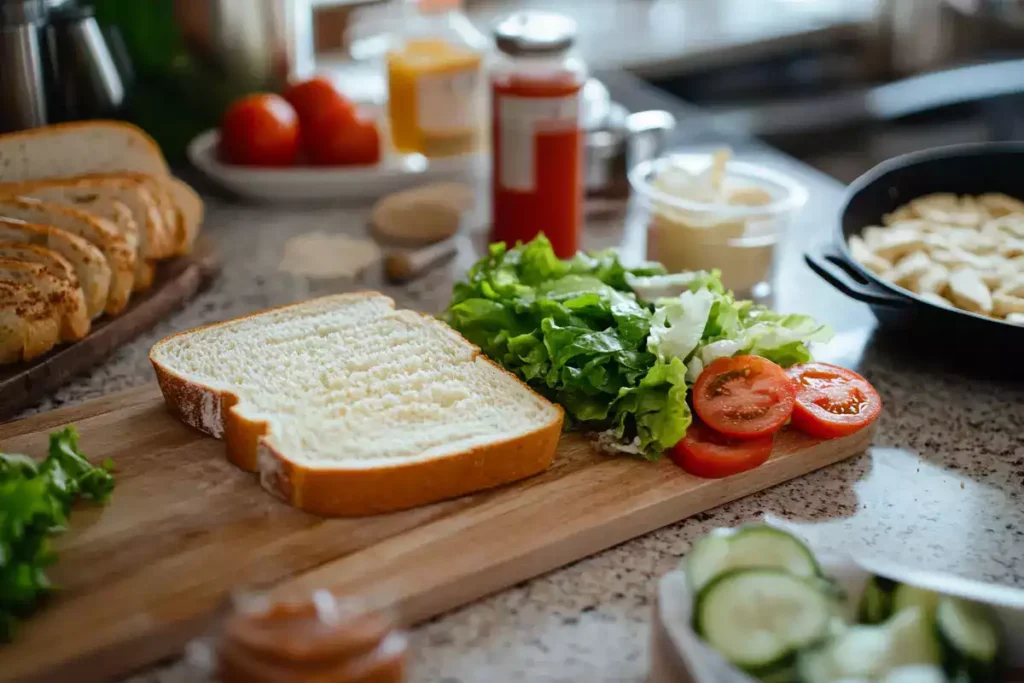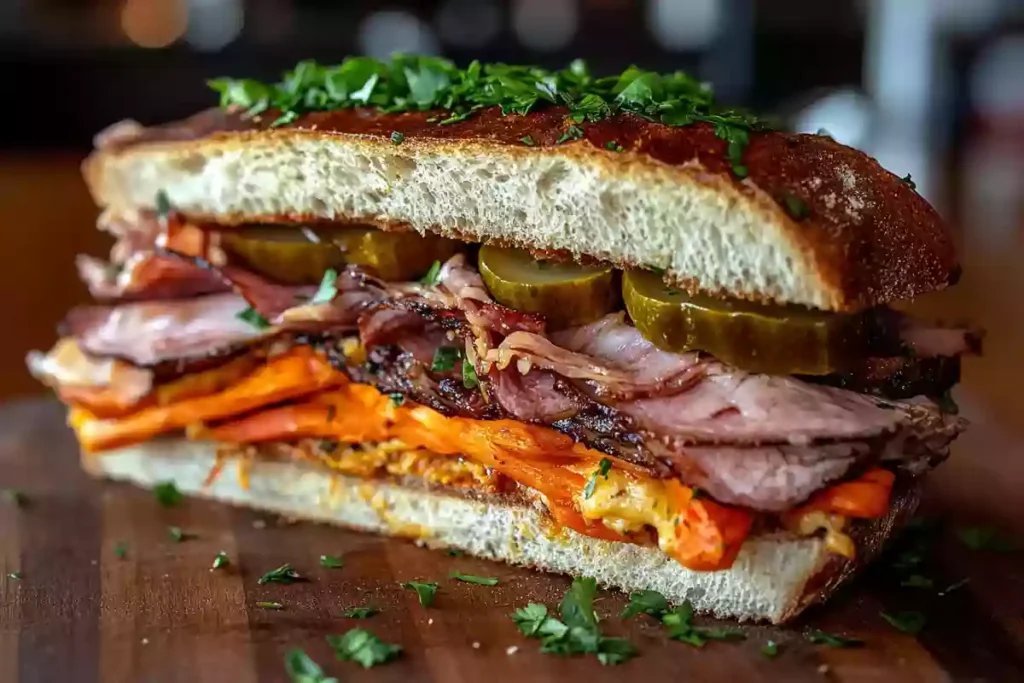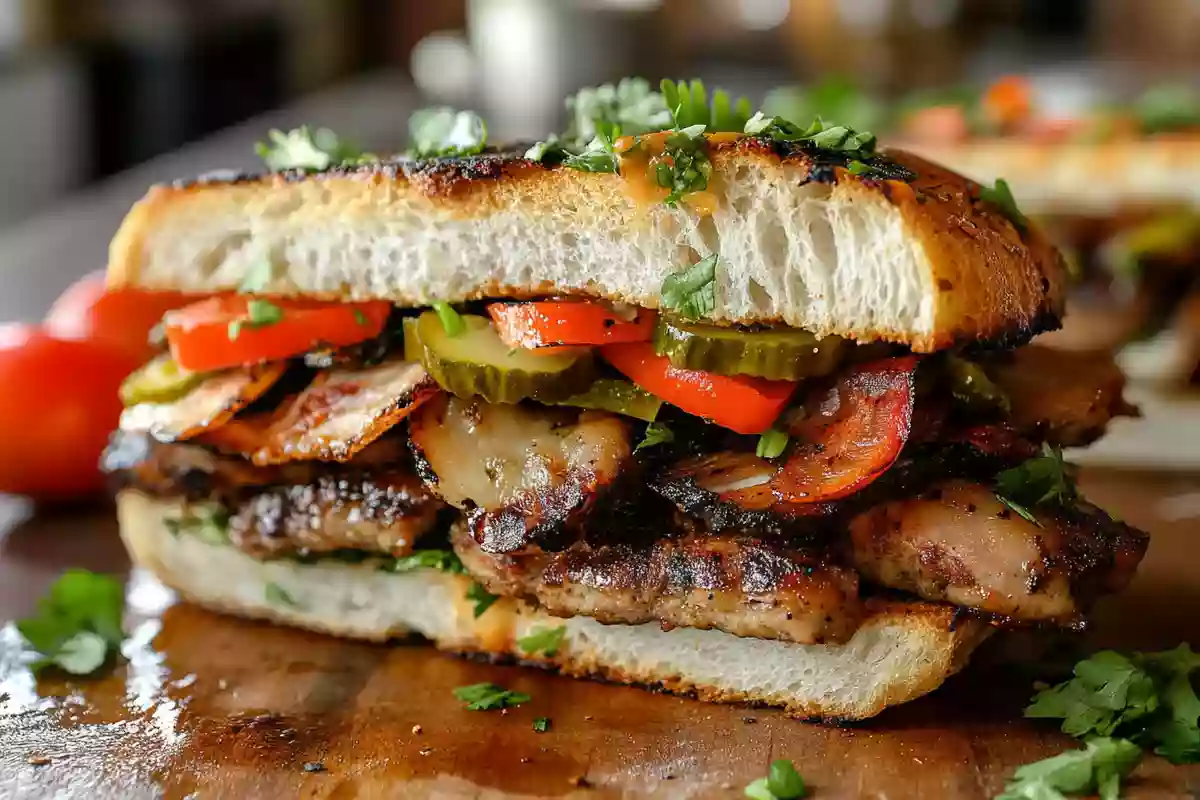Sandwiches are an enduring favorite, cherished for their versatility and universal appeal. Among the myriad sandwich varieties lies the knob sandwich, a term that might pique your curiosity. This article delves into the fascinating world of the knob sandwich, from its intriguing origins to its culinary anatomy and even how you can craft the perfect one at home. Whether you’re a sandwich enthusiast or just looking to expand your culinary horizons, you’re in for a treat!
Table of contents
- Introduction to the Knob Sandwich
- Culinary Anatomy of a Knob Sandwich
- Historical and Cultural Perspectives
- How to Make the Perfect Knob Sandwich
- Health Perspectives
- FAQs About knob sandwich
- The Future of the Knob Sandwich
- The Environmental Impact of Sandwich Making
- The Community Around Knob Sandwiches
- Conclusion and Final Thoughts
Introduction to the Knob Sandwich
What Is a Knob Sandwich?
At its heart, the knob sandwich is a culinary concept that’s as simple as it is intriguing. While it might sound like a niche or regional delicacy, the term often garners attention for its quirky name. The phrase can refer to a robust, hearty sandwich designed to satisfy big appetites, or it may symbolize a playful nod to sandwich culture. Either way, the knob sandwich stands out for its uniqueness.
Origins of the Term “Knob Sandwich”
The origin of the term “knob sandwich” is shrouded in a mix of cultural and linguistic lore. Some suggest it’s a humorous term popularized in British slang, while others argue it may have culinary roots tied to rustic, handmade sandwiches. Historically, “knob” referred to a small rounded object, which might hint at the sandwich’s shape or size.
Cultural Significance and Popularity
The knob sandwich isn’t just a meal—it’s an experience. Its playful name has made it a conversation starter, and its hearty nature has secured its spot among beloved sandwiches. While it’s not as globally recognized as a BLT or Reuben, the knob sandwich has carved out a niche among those who appreciate bold flavors and creative culinary expressions. Social media platforms have amplified its popularity, inspiring enthusiasts to share their versions of this unconventional delight.
Culinary Anatomy of a Knob Sandwich
Core Ingredients: Bread and Fillings
The knob sandwich isn’t defined by a single set of ingredients but instead by its bold, hearty composition. At its base, you’ll often find rustic, artisan bread that provides a sturdy foundation. Sourdough, ciabatta, or whole grain are popular choices for their ability to hold up against generous fillings without becoming soggy. The fillings are where creativity shines—meats like roasted beef, turkey, or smoked ham often pair with fresh veggies, flavorful spreads, and tangy pickles.
For vegetarian spins, roasted eggplant, zucchini, and hummus can create a memorable bite. Adding contrasting textures, such as crispy lettuce or crunchy onions, elevates the sensory experience of enjoying this sandwich.
The Ideal Ratio: Bread-to-Filling Proportions
A great knob sandwich is all about balance. Too much bread can overwhelm, while overloading the fillings can result in a messy eating experience. The ideal ratio is roughly two-thirds filling to one-third bread, allowing the flavors to shine without overshadowing the base. Layering the ingredients thoughtfully—starting with spreads on the bread to prevent sogginess—helps maintain structural integrity.
Common Variations and Regional Twists
Globally, sandwiches reflect regional tastes, and the knob sandwich is no different. Some versions embrace spicy chipotle sauces or smoky barbecue fillings, while others lean into Mediterranean influences, incorporating olives, feta, and sundried tomatoes. Experimenting with these variations lets you cater to specific cravings or cultural preferences.
Historical and Cultural Perspectives
Tracing the Evolution of the Knob Sandwich
The origins of the knob sandwich are rooted in the age-old tradition of portable meals. Historically, laborers and travelers needed nourishing, convenient options, which led to the invention of the sandwich. The knob sandwich, with its hearty fillings, likely evolved from this necessity, adapting to modern tastes and ingredients over time.
Though not as storied as the Reuben or Cuban, the knob sandwich has carved its niche as a symbol of satisfying, no-nonsense eating.
Cultural Representations in Media and Literature
Interestingly, the knob sandwich has found occasional mention in popular culture, often humorously. Its name lends itself to quirky anecdotes or expressions, ensuring its place in contemporary slang. Social media has amplified its appeal, with food enthusiasts sharing creative takes on this classic, fueling its cult status.
International Comparisons: Sandwich Variants Around the World
When comparing the knob sandwich to its international counterparts, its hearty nature stands out. In Scandinavia, open-faced sandwiches like Smørrebrød emphasize elegant simplicity, while the Italian panino highlights the interplay of cured meats and cheeses. The knob sandwich aligns most closely with the stacked sandwiches popular in the U.S., where bold flavors and hearty servings reign supreme.
How to Make the Perfect Knob Sandwich
Step-by-Step knob sandwich Recipe Guide
Creating a knob sandwich at home is easier than you might think. Here’s a simple yet delicious recipe to try:
- Gather Your Ingredients: Start with two slices of hearty bread, such as sourdough or rye. Choose protein-rich fillings like roasted turkey or grilled vegetables for a vegetarian twist.
- Prepare Your Fillings: Layer your sandwich with a base of fresh greens, add thinly sliced tomatoes, and spread your favorite condiment (mayo, mustard, or hummus).
- Stack Thoughtfully: Balance flavors by adding a salty or tangy element, such as pickles or a slice of sharp cheddar cheese.
- Toast for Texture: For added crunch, lightly toast the sandwich on a skillet or in a sandwich press until golden brown.
By following these steps, your knob sandwich will deliver a delightful combination of flavors and textures.

Tips for Choosing High-Quality Ingredients
The secret to a great knob sandwich lies in the quality of its ingredients. Use freshly baked bread, seasonal vegetables, and premium-quality meats or plant-based proteins. Don’t hesitate to experiment with homemade condiments to add a personal touch. Local farmers’ markets can be excellent sources for fresh produce and artisanal bread.
Serving Suggestions and Pairings
Pair your knob sandwich with a light side to complete the meal. A crisp green salad, kettle-cooked chips, or a bowl of hearty tomato soup makes for an ideal accompaniment. Beverages like iced tea, lemonade, or even a frothy craft beer can elevate your dining experience.
For more delicious recipe ideas, check out the recipe articles on the Menus Recipes website.
Health Perspectives
Nutritional Benefits and Concerns
The knob sandwich can be as healthy as you make it. When packed with fresh vegetables, lean proteins, and whole-grain bread, it becomes a nutrient-dense meal rich in fiber, vitamins, and protein. However, it’s essential to watch portion sizes and avoid excessive high-calorie spreads or overly processed ingredients.
For those seeking lighter options, swap mayonnaise for avocado spread, choose low-sodium deli meats, or use whole-grain wraps instead of traditional bread. These small changes can significantly impact the sandwich’s nutritional profile.
Customizing for Dietary Preferences
One of the best aspects of the sandwich is its adaptability. It can cater to virtually any dietary preference:
- Vegetarian or Vegan: Replace meats with grilled eggplant, mushrooms, or a plant-based protein like tempeh. Use vegan cheese and egg-free spreads.
- Gluten-Free: Opt for gluten-free bread varieties made from almond or rice flour.
- Low-Carb or Keto: Use lettuce leaves or keto-friendly bread alternatives to keep carbohydrates in check.
The possibilities are endless, allowing everyone to enjoy this iconic sandwich without compromising their dietary needs.
FAQs About knob sandwich
What Is a Knob Sandwich?
A knob sandwich is more than just a hearty meal—it’s a celebration of bold flavors and satisfying textures. Known for its rustic appeal and robust ingredients, the sandwich is a popular choice for those craving a filling, flavorful bite. Whether loaded with roasted meats, fresh veggies, or a mix of gourmet condiments, this sandwich offers endless possibilities for customization.
What Is a Swedish Open Sandwich Called?
In Sweden, the open sandwich is called Smörgås or Smørrebrød in neighboring Denmark. Unlike the sandwich, which is typically stacked with fillings and enclosed by bread, the Swedish version showcases its toppings on a single slice of bread. Often decorated with smoked fish, pickled vegetables, and fresh herbs, these open sandwiches focus on presentation and flavor balance.
What Are the Two Types of Sandwiches?
Broadly, sandwiches can be categorized into two types: closed sandwiches, like the sandwich, where the fillings are layered between two slices of bread, and open sandwiches, like Smörgås, where toppings are placed on a single slice of bread. Both types cater to different tastes and occasions, making sandwiches a universally loved meal option.
What Is a New Orleans Sandwich Called?
In New Orleans, the sandwich that reigns supreme is the Po’ Boy. Known for its crispy French bread and generous fillings—like fried shrimp, roast beef, or oysters—it offers a unique taste of Southern cuisine. Much like the sandwich, the Po’ Boy is beloved for its satisfying flavors and hearty portions.
The Future of the Knob Sandwich
Innovative Trends in Sandwich Making
The culinary world is constantly evolving, and the sandwich is no exception. Chefs and food enthusiasts are embracing global flavors and sustainable ingredients to elevate this classic meal. Think kimchi-infused spreads, plant-based proteins, and bread varieties like sourdough infused with herbs or seeds. These innovations not only enhance taste but also make the sandwich more appealing to modern palates.

Adapting to Modern Tastes and Preferences
As dietary preferences shift, the sandwich continues to adapt. Gluten-free, keto-friendly, and vegan versions are gaining traction, ensuring that everyone can enjoy this versatile dish. Additionally, convenience is key—pre-made options at gourmet delis or creative DIY kits are making it easier than ever to craft a personalized sandwich at home.
Looking ahead, the sandwich seems poised to remain a staple in kitchens and menus worldwide. Its endless adaptability, combined with a rich history and bold flavors, ensures its spot as a timeless favorite.
The Environmental Impact of Sandwich Making
Sustainable Practices in knob sandwich Ingredients
The growing popularity of the knob sandwich offers an excellent opportunity to promote sustainability in the kitchen. By choosing locally-sourced and seasonal ingredients, sandwich lovers can minimize their carbon footprint. Opting for organic vegetables, free-range meats, and bread made from sustainably farmed grains ensures that every bite is environmentally friendly.
Reducing food waste is another critical consideration. Leftovers, such as roasted vegetables or grilled chicken, can be transformed into delicious sandwich fillings, giving them a second life while saving resources.
Packaging and Serving: Eco-Friendly Alternatives
How you package and serve your knob sandwich can also make a difference. Reusable containers, beeswax wraps, and biodegradable napkins are practical, eco-friendly alternatives to single-use plastics. Many artisan bakeries now offer bread wrapped in recyclable paper, further supporting a greener approach to sandwich-making.
With small changes like these, enjoying a knob sandwich can be a guilt-free indulgence that aligns with modern environmental values.
The Community Around Knob Sandwiches
Social Media’s Role in Sandwich Trends
Social media has turned the knob sandwich into a viral culinary icon. Platforms like Instagram and TikTok are filled with mouthwatering photos, recipes, and creative twists on this classic dish. Food influencers have popularized ideas like “build-your-own-sandwich” nights, inspiring others to experiment and share their unique creations.
Hashtags like #KnobSandwichChallenge and #EpicSandwich have cultivated a vibrant community of food enthusiasts who exchange tips and tricks for making the perfect sandwich.
Local Sandwich Shops and Their Influence
Independent sandwich shops have also embraced the knob sandwich as a canvas for culinary creativity. From local delis to high-end cafes, chefs are incorporating regional flavors and artisanal techniques to offer distinctive variations. These establishments often prioritize fresh, locally-sourced ingredients, creating sandwiches that reflect the community’s character.
By supporting these local businesses, sandwich lovers not only enjoy a top-notch knob sandwich but also contribute to their local economy and food culture.
Conclusion and Final Thoughts
The knob sandwich is much more than a meal—it’s a versatile and creative culinary experience. From its hearty ingredients to its adaptability for modern tastes, this sandwich has something for everyone. Whether you’re crafting one at home, enjoying it at a local deli, or exploring sustainable practices, the knob sandwich continues to evolve while staying true to its roots.
So, why not dive in and create your own masterpiece? With endless possibilities, the knob sandwich is sure to satisfy your cravings and inspire your inner chef. Here’s to many delicious bites!

